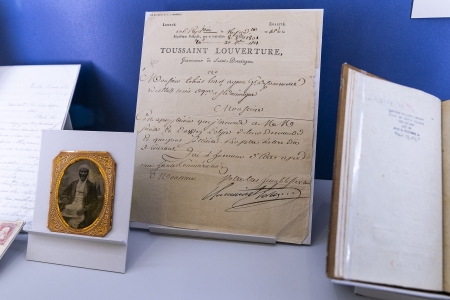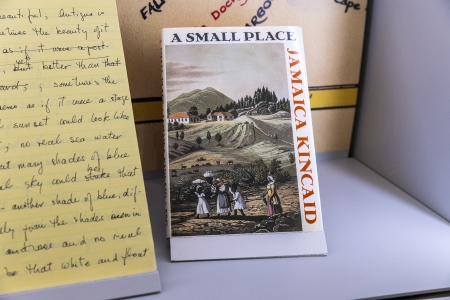
Chloe McKain, a Harvard College sophomore and President of the Harvard Caribbean Club, had a busy year. In May, an exhibit that she guest-curated opened at Houghton Library. The Caribbean: Sea of Resilience highlights Houghton’s Caribbean materials, and celebrates the creativity, strength, and history of the Caribbean people. She sat down with Harvard Library to tell us about the experience.
Harvard Library: Can you tell us a little bit about the exhibit, and what it means to you?
McKain: The exhibit is a collection of significant pieces held at Houghton that tell a story about the Caribbean people’s resilience. I wanted to show the development of the Caribbean, showcase Caribbean culture, and spotlight the Caribbean people’s resistance to colonial oppression. Colonial history is tied throughout all the pieces. Every single piece shows what has been done by the people of the Caribbean to resist oppression, and that’s why I called the exhibit The Caribbean: Sea of Resilience.

Curating this exhibit was a pivotal moment not just in my academic career but in my life, because for so long I had been told that my history does not exist, that it was thrown overboard a slave ship and buried somewhere at the bottom of the Atlantic Ocean. I don’t think people ever realize the value of recorded history until you have it taken away.
HL: Most of the cases hold a pair of items in conversation with one another, which was striking. How did you select the items?
McKain: I thought it was very important to have these items be in dialogue with each other and to show off different points of view. Anne-Marie Eze, Director of the Public Engagement Project and Associate Librarian for Collections and Programs, and Peter Accardo, Librarian for Scholarly and Public Programs, had selected some items before I joined the project, but I selected many of the other items in the exhibit.
One of the items they had picked was Columbus’s letter to the Spanish court describing his findings on his Caribbean voyage. I paired it with the manuscript of the Kamau Brathwaite poem, “Colombe,” from the book Middle Passages. Brathwaite is an important and influential poet and writer, not only to the Barbadian people, but for Black people around the world. There was a clear story being told there, with two very different points of view.
HL: What was it like to curate an exhibit? Did anything surprise you?
McKain: It was more difficult than I expected. Again and again, I had to ask myself, what’s the theme I am trying to pick up on? What story am I trying to tell? I might find an item in the collections that goes very well with the theme, but then I had to ask, what will people see visually when they walk into the exhibit? Is it colorful, is it visually pleasing? Does it make sense? What will they get from it? Anne-Marie and Peter were so knowledgeable, and they know how people move through an exhibit space, and how they regard the materials. There were great pieces that we couldn’t include because they didn’t fit the visuals or they didn’t fit the theme. We had to consider size as well, as some things actually can’t fit in the case!
HL: What did you learn through the curatorial process about the Caribbean and about yourself?

McKain: There are so many things that I learned, including a lot of history. Houghton has a boxful of Jamaica Kincaid’s handwritten manuscripts, and we wanted to include a Kincaid item. Looking through the Kincaid papers, we had to figure out which ones were in good condition, presentable, and fit the theme. We ended up selecting her book about Antigua, A Small Place, which is a long essay about colonialism. I learned a lot about the Lesser Antilles. For people in countries with a colonial past—you can’t just get out of it, it affects people to this day, so that’s why we went with that one. When choosing the actual edition, I really liked the cover of that version in the case, because it features a group of women outside. It speaks to the female voice which is overlooked when it comes to the Caribbean story. Women have played a strong role in Caribbean history, and this was a way to represent that.
HL: Is there anything else you want to tell us about the exhibit?
McKain: The most rewarding part of guest-curating this exhibit was just seeing people’s responses to the exhibit when we did the curatorial tour. Mayor Michelle Wu’s Haitian Cultural Advisor Jean Julien and Caribbean Cultural Advisor Bianca Rose came to see the show. It’s so rewarding to be able to bring these pieces to the public. The colonial past is very hard to grapple with, but we have to do our best, and record and preserve and share these stories when we can. I hope this exhibit can make people see the resilience, the resourcefulness, and the creativity of the Caribbean people.
Open to the public, the exhibit is on view through August 22, 2025.